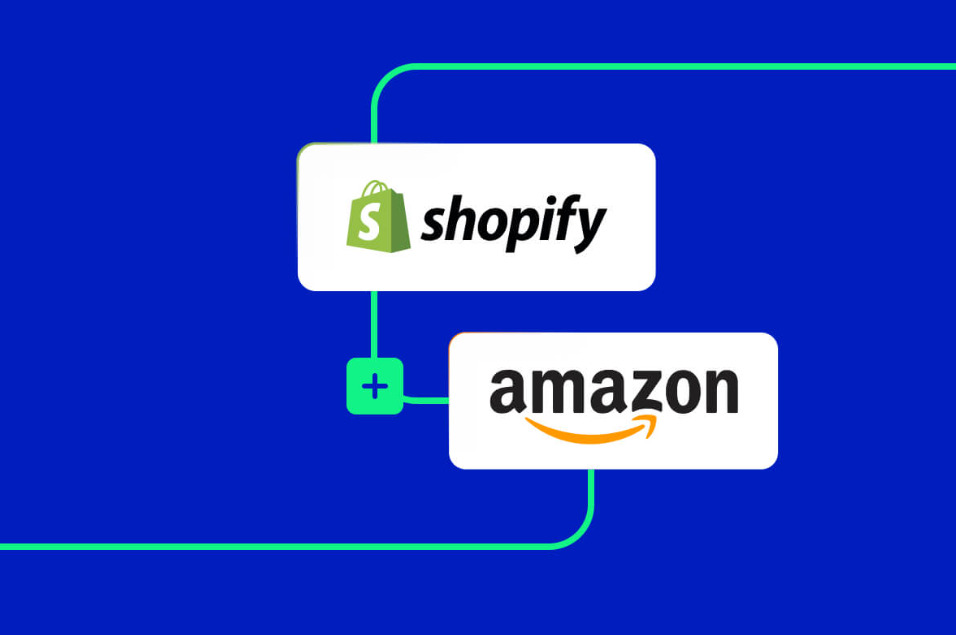Exploring the potential of Shopify Amazon Integration becomes only natural, as we consider two leading options for expanding E-commerce businesses including Shopify & Amazon Seller Central.
Renowned for its customizable features, Shopify offers businesses a comprehensive shopping cart platform: one they can use to build their store and sell directly across multiple channels to consumers. Contrastingly, as the world’s largest marketplace – a position that requires no introduction – Amazon provides an expansive audience for sellers, vendors, and brands alike to leverage.
If you’re here, chances are that either you already sell on both platforms or are contemplating doing so. In either case, maximizing the potential of selling on Shopify and Amazon is essential. Therefore – how can this be achieved?
Targeting the aspects that unnecessarily drain your time, effort and money holds the key. Integrating Shopify with Amazon eliminates tedious tasks: this is where it becomes crucial. If you have not yet heard about this integration – rest assured, that an astonishing avenue to amplify their brand presence on Amazon has been introduced for merchants by Shopify. And the best part? There are many Shopify Amazon integration apps available on the Shopify app store to facilitate this process.
Discover more: Top 14+ Free eCommerce Platforms to Start Online Businesses
The article by BSS Commerce Shopify will give you the ultimate guide and best practices about Shopify Amazon Integration.
Let’s discover!

Contents
Understanding Shopify Amazon Integration
Online sellers should be very aware of Shopify Amazon Integration, often known as integrating Shopify with Amazon. The word can be simply understood as “the process of connecting your Shopify online store with the Amazon marketplace” which enables you to integrate your Shopify store with the enormous Amazon marketplace.
Then, in detail, how can it enhance your business operation? Integrating Shopify with Amazon holds immense importance for online retailers as it opens doors to a multitude of benefits and unlocks a world of opportunities to enhance their business operations. It offers numerous advantages that can significantly impact your business growth and then take it to the next level.
Enhance brand recognition with a vast customer base
Tapping into Amazon’s massive customer base and leveraging its strong brand recognition has one major benefit: the potential to reach millions of active customers – people actively searching for products on Amazon, and eager to make purchases. By listing your products there, you enhance not only your brand’s visibility but also exposure in an unprecedented manner.
Streamline business operation
Your business operations can be streamlined by connecting Shopify to Amazon. Rather than managing separate inventories and sales channels, inventory sync Shopify to Amazon empowers you to order tracking and management seamlessly. This action conserves valuable business time, furthermore, it averts errors or discrepancies—effectively eliminating manual inventory updates.
Increase sales and revenue
Linking Shopify to Amazon offers an additional advantage: it enhances the potential for increased sales and revenue. This Shopify integration with Amazon not only provides you with access to Amazon’s robust marketing tools but also lucrative advertising opportunities. Leveraging Amazon’s high conversion rates and customers through sponsored product ads and targeted promotions – can amplify your Shopify store’s visibility significantly. Effectively, it promotes your products and enhances sales.
Seamless integration with Amazon analytics
Moreover, this integration provides invaluable insights and data analytics via Amazon’s reporting and analytic tools. The advantages extend to tracking sales performance analysis; observing customer behavior patterns-and discerning product trends. Such rich data informs crucial business decisions; it optimizes listings of products–refining marketing strategies for superior results.
How to Connect Shopify to Amazon
In this section, we will explore the step-by-step process of how to integrate Shopify with Amazon seamlessly, enabling you to streamline operations and enhance your e-commerce capabilities. Follow along to ensure a smooth and efficient integration that maximizes the strengths of both platforms.
Establishing Your Amazon Seller Account
Initiating the Shopify Amazon integration process requires you to first set up your Amazon Seller Account. Begin this by establishing an account on the website of Amazon Seller Central. To complete registration, follow the provided instructions meticulously and provide all necessary data as requested. Once you have successfully created your account, feel free to proceed to the next stage.

Integrate your Shopify Store with Amazon
Next, to connect Amazon with Shopify store, you’ll require a reputable Shopify Amazon integration app or software for guaranteed success. Numerous options exist – the Shopify Amazon Integration apps on the Shopify App Store and various other third-party integration tools are among them. Select the solution that aligns with your requirements; subsequently, install it within your Shopify store. Proceed to follow the instructions provided by the chosen application for linking to your Amazon Seller Account: Ensure – through thorough examination – that all of your products meet their specific criteria.
Further, familiarize yourself meticulously with the platform’s selling guidelines: This precautionary measure will enable you not only to circumvent future infractions but also to avert potential problems – a strategic approach crucial in maintaining optimal operational efficiency and professionalism.
Synchronizing Your Products
After you install the Shopify Amazon integration app, it actively guides you to connect Shopify store to Amazon and synchronize your products. You must heed its instructions for establishing a secure connection between your Shopify store and Amazon.
Moreover, maintaining consistent – as well as accurate – product information across both platforms is crucial; ensure that diligently. Titles, descriptions, images, and pricing constitute this. Please keep in mind that Amazon possesses its unique guidelines and requirements for product listings; thus – ensure your compliance by investing time to familiarize yourself with them.

You may concern: Best Products to Sell on Shopify
Achieving Successful Integration of Shopify and Amazon
An effective integration necessitates adherence to certain best practices: outlined below are the essential steps for a successful Shopify Amazon integration – all undertaken with the intent of broadening your E-commerce business audience.
Optimize product listings for Amazon Marketplace
If you wish to differentiate yourself from the competition, enhance visibility, and boost conversions on Amazon, optimizing your product listings is imperative. Invest time in researching applicable keywords: incorporate them into not only your product titles but also descriptions – even bullet points.
Furthermore – employ high-quality images and provide comprehensive yet concise information about the products, precision matters greatly here. Adhere to Amazon’s product listing guidelines: this strategy enhances your ranking potential in search results, thereby attracting increased attention to your listings.
Explore some tips with Mastering Resize Image for Shopify: Step-by-Step Guides
The execution of pricing and inventory strategies
This is a critical task in the business world – one that demands careful consideration, strategic planning, and adept implementation. It requires an acute understanding of market dynamics, and customer behavior patterns, as well as a firm grasp on internal operations.
Efficiently managing pricing and inventory on Shopify and Amazon necessitates the implementation of intelligent tactics. Consider employing dynamic pricing strategies if you wish to adjust your prices in response to market demand and competition. Conduct a comprehensive analysis of your competition on Amazon, then competitively price your products.
Ensure your prices appeal to Amazon shoppers seeking the best offers, while still maintaining profitability. To avoid overselling and stockouts, guarantee an exceptional customer experience, and boost revenue; synchronize your inventory between Shopify and Amazon.
Actively streamlining the processes of order fulfillment and shipping
Flawless consumer interaction proves crucial when connecting Shopify to Amazon. Utilize fulfillment services such as Amazon FBA – Fulfillment by Amazon – for managing storage, packaging, and shipping. This ensures fast, reliable delivery of your orders on Amazon while alleviating the workload on your team.
To streamline fulfillment and circumvent manual errors, actively synchronize order information between Shopify and Amazon. Particularly if your objective is to penetrate Amazon’s Prime customer base and exploit their efficient shipping services, adopting this strategy proves exceptionally advantageous.
Discover 15+ Shopify Shipping Apps To Boost Your E-Commerce Success
Monitor and analyze performance metrics
Linking Shopify to Amazon, it becomes crucial for you to regularly monitor your sales and performance indicators across both platforms. The Seller Central dashboard of Amazon provides a variety of reporting and analytics capabilities. Therefore, keep a vigilant eye on vital metrics: order fulfillment rate, customer feedback, and search term performance – these are indicative factors that require constant scrutiny. You can use this to measure the effectiveness of your strategies; subsequently, you may implement adjustments for improved visibility-enhancing both sales and customer satisfaction on Shopify and Amazon.
See more: Top Customer Review Apps for Shopify
Shopify Amazon Integration: Common Challenges and Solutions
Shopify integration with Amazon, like any amalgamation, may pose typical challenges for online sellers. A smooth and successful integration hinges on our awareness of these primary issues; we must actively seek out solutions to ensure its efficacy.
Issues with Shopify Amazon inventory sync
One must actively maintain inventory synchronization as a key challenge in linking Shopify to Amazon: specifically, ensuring that stock levels remain appropriately updated across both platforms when simultaneous selling occurs. To address this issue effectively, employ a Shopify Amazon integration app, however, exercise due diligence to select one that is trustworthy and committed.
By automatically synchronizing and updating your stock levels in real-time on both platforms, it accelerates the process. Should you experience any issues with the app – thus avoiding overselling or disappointing customers due to canceled orders because of insufficient stock – contact Shopify support service immediately.
Dealing with Amazon’s pricing and competition management
Setting competitive prices while maintaining profitability remains critical, as numerous suppliers vie for customers’ attention. Ensure, first and foremost, that your products align with applicable intellectual property rights – as well as Amazon’s standards and category constraints. Employing Amazon’s pricing tools – a resourceful strategy to track market trends – that enables you to adjust rates effectively is advisable; as manual consistency in monitoring and modifying prices poses difficulties.
Moreover, by providing value-added services such as expedited shipping or exclusive package discounts, you can effectively differentiate your products from competitors. Outperforming rivals becomes achievable when consistently monitoring Amazon’s Buy Box feature and enhancing product listings – a strategy that ensures optimal visibility and competitiveness on the platform.
Handling customer reviews and addressing feedback
These are essential tasks in managing a business’s online reputation. The comments and reviews of your customers significantly shape your Amazon reputation, since Amazon values customer feedback for establishing goods’ authority and visibility. Therefore, negative comments or feedback – by impacting both sales and brand image – are consequential in their influence on your business. Offering incentives and communicating through personalized follow-up emails are proactive methods to encourage satisfied consumers to submit positive evaluations.
Conversely, should a disgruntled reviewer emerge, respond swiftly and professionally. Let your reply display not only your commitment but also an unyielding determination to resolve any issues at hand. Swift, effective response to consumer complaints and feedback instills trust in your brand from clients, it’s a key indicator of professionalism and customer-centric operation.
Conclusion
In conclusion, please note a few key points: Shopify Amazon integration – whether you initiate your sales on Shopify and later aspire to expand onto Amazon, or inversely; begin with Amazon but plan for cross-channel availability via Shopify – presents vast potentiality for business growth. If you haven’t yet integrated your Shopify store with Amazon, now is the opportune time.
By linking your platform to Amazon, you gain the capacity for seamless inventory management. Additionally, product listings are automatically synchronized across both channels – an efficient time-saver – and order fulfillment is expedited through shared resources. All factors can significantly enhance customer satisfaction in this era where convenience reigns supreme. This integration, leveraging Amazon’s robust infrastructure and impeccable reputation as an online marketplace known for reliability, enables a swift and efficient reach to millions of potential customers.
Discover now: Mailchimp to Shopify Integration: Beyond The Effective Email Marketing




